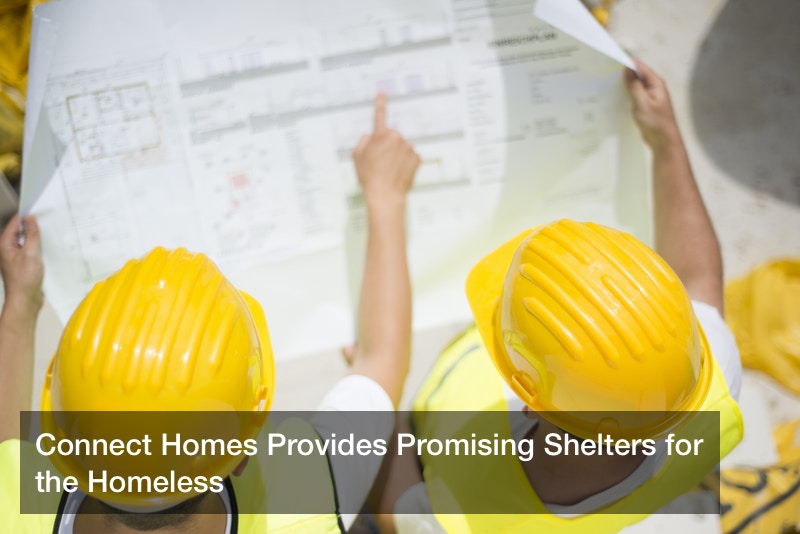
Homelessness is an epidemic in the United States, to a surprising degree considering the nation’s wealth and development. Although the issues that lead to homelessness are vast, the COVID-19 pandemic of 2020 has left thousands of Americans uncertain of whether or not they will be able to maintain their homes for the future. Not only are many unable to keep up with their mortgage payments; even rent is becoming increasingly difficult for tenants to pay. While rent and eviction moratoriums early in the pandemic helped individuals in crisis to an extent, currently many of them are still struggling to make their payments. Fortunately, there are options available for homeless Americans. In this case, it comes in the form of Connect Homes, a company that has is giving homes to the homeless.
Founded in 2013 and located in Los Angeles, California, Connect Homes began with a focus on creating modern, sustainable homes for buyers. Specializing in prefabricated modular construction, these home builders understood that this particular approach was more affordable and while also offering buyers the ability construct new homes out of recycled materials. The building process behind Connect Homes has been streamlined to an assembly line, which not only is safer for laborers but also significantly cuts costs. The amount of time needed to create a building is reduced due to Connect Homes’s systematic approach, and for that matter there is often less labor required in general.
Perhaps even more significantly, Connect Homes is able to predict its costs accurately, with relatively little deviation. A major concern for both home buyers and builders is how quickly a budget can grow out of control when certain materials become unavailable, or when a room must be expanded due to building conditions. In the past, it has been difficult to pursue giving homes to the homeless because of these unforeseen costs that come with construction. The process utilized by Connect Homes minimizes this issue and can be applied to constructing both temporary and permanent modular shelters for people experiencing homelessness.
Understanding the Barriers for Eliminating Homelessness

Just as the reasons behind homelessness existing are vast, so too are the barriers for eliminating homelessness. One of the main issues is cost, which is why the plans put in place by Connect Homes are so intriguing. It can be difficult for current state budgets to explore giving homes to the homeless, especially when that population is experiencing a potential growth spurt as it is due to COVID-19. As previously mentioned, housing traditionally is expensive to build. Often, these costs come from the prices behind building materials, as well as labor and land.
But at the same time, if it is difficult to give homes to the homeless, it’s also difficult to expect the homeless population to seek housing. Once an individual becomes homeless, it’s quite difficult for them to find housing, and they are much more at risk of becoming homeless again if they do find solutions. Many shelters have restrictions in place, often refusing stays for people suffering from substance abuse disorders or those with violent criminal records. Although this is understandable under some circumstances, it still leaves a significant portion of the homeless population without shelter. For that matter, those that do suffer from substance abuse disorders often cannot afford addiction services. They also are are offered more opportunities to use substances while in high-situations often encountered during periods of homelessness.
These issues can lead to difficulty in finding the types of jobs that would make it easier for individuals to pay for housing. Joblessness is a major contributing factor to homelessness. Currently, the COVID-19 crisis has deprived millions of Americans of their jobs, and entire career fields have been put on hold due to the pandemic. But the reality is that many Americans struggled with joblessness prior to the pandemic, and become homeless can make it hard to find a new job. Simply being unable to dress oneself for a job interview or take consistent showers can jeopardize an individual’s ability to get a job; as can a lack of consistent access to the internet, where most companies post job applications today. Homelessness and joblessness together can cause an individual to experience problems with their personal credit history, which is checked by many employers before a job is granted. of course, even if an individual is able to get a job their credit history will also frequently be checked by potential landlords and lenders. Even without these obstacles, housing is simply expensive. With the average down payment for a mortgage necessary to buy a house being around $12,829 in 2017, housing is unattainable for many at this time.
Essentially, homelessness in itself creates an ongoing cycle of trouble for individuals. However, it can be difficult for the state to provide proper, cost-efficient housing both temporary and permanent for those in need of homes. This is why efforts like Connect Homes interest in giving homes to the homeless is so important. Not only is Connect Homes doing important work right now; the company is also modeling for other companies and potentially state governments how their mission can be accomplished. Indeed, the systems put in place by Connect Homes could offer more affordable options than those offered by traditional homeless shelters.
How the Connect Homes Approach is Providing Solutions

Oftentimes, there is an understandable perception that affordability means offering lesser materials. This is why, quite often, halfway houses or other forms of housing provided for individuals experiencing homelessness can seem to be more low quality. It is not necessarily that those offering this housing believe that individuals experiencing homelessness deserve lesser standards of living. Rather, the procedure of giving homes to the homeless is often dependent on tight budgets and the goal for many organizations is to provide as much housing as possible, as affordably as possible.
Connect Homes is actually able to offer a solution in part because many of the materials that they use to construct temporary and permanent modular shelters for homeless individuals are the same materials that they use for their other projects. This means that they are able to get economies of scale throughout the building process. Despite the fact that modular housing tends to rely upon similar designs and overall frames, there is flexibility allowed within these structures. When giving homes to the homeless, it’s important to consider that oftentimes, homeless individuals are seeking shelter for multiple people at once. They may be looking for housing in friend or family groups, and it’s important that these groups are able to stay together.
Therefore, the structures provided by Connect Homes can provide either two or four small private bedrooms. The number of the bedrooms will be dependent upon whether or not the structures include private kitchen and bathroom designs, as the space is essentially divided into four units taking up 320 square feet. Although this is a part of the process of giving homes to the homeless, these are not full-length massive houses. Yet there is more individual space than is often provided by larger houses that are sometimes sourced and built by alternate programs. If the housing solutions provided by Connect Homes are used to create these larger sorts of villages, these units can also be alternately used to provide larger kitchen, bathroom, or laundry room spaces.
Another reason why Connect Homes’s modular structures are often more affordable is that they provide multiple options in terms of power. Energy can be massively expensive for homeless shelters, as a single shelter can house dozens of people all using electricity, water, and natural gas. E The modular shelters provided by Connect Homes can function on- or off-grid, and can also be powered through solar panels. Solar panels can help keep energy costs affordable, but are not always accessible for many shelters today. Bedrooms are provided with air conditioning and filters, allowing for both comfort and health. Furthermore, these structures are easy and inexpensive to ship, as they are equivalent in size to 40-foot shipping containers.
The individuality offered by Connect Homes is incredibly important not merely in terms of its humanizing factors, allowing people to have the space that they need, but in terms of cleanliness. Their units can come with separate mechanical and residential plumbing systems, as seen in the above-mentioned two-room units. In these cases, this minimizes the risk of contamination. Clearly, this is especially important in a post-pandemic world.
Putting these Plans into Action

Generally speaking, the modular shelters provided by Connect Homes can cost as little as $20,000 per bed. This means that they can be covered at least in part by many grant and loan programs offered for organizations providing shelter for the homeless population. They can be constructed in less than 90 days, and offer not only a flexible present but a flexible future. This can be seen in the approach used by LifeMoves, a Bay Area nonprofit that is exploring giving homes to the homeless through the options provided by Connect Homes.
After partnering with the City of Mountain View, LifeMoves received a grant from HomeKey. A state program, HomeKey in particular focuses on providing houses for Californians during the pandemic. Connect Homes is creating 88 bedroom units for LifeMoves, which will ultimately be the basis of a kind of hotel for individuals experiencing homelessness in California. The intriguing thing about these units is that they will actually be removed in 10 years and relocated. Therefore, the land upon which they sit can be redeveloped. This underscores the sustainability of the units provided by Connect Homes. They will essentially be recycled for different projects in different locations in the future. Potentially in alternate projects, these types of units can be used as temporary housing for individuals experiencing homelessness, after which they will be replaced with permanent housing.
The rapidity with which these solutions can be implemented means that Connect Homes shelters can be deployed in crisis scenarios. Consider how much sturdy, safe, temporary housing is needed after a natural disaster like a massive hurricane. These structures can be shipped and constructed quickly and affordably, disassembled and removed just as quickly after they are no longer needed. Furthermore, the structures are high quality, and that quality is not affected by whether they are temporary or permanent. These modular structures are built with Connect Homes’s patented prefab steel frame system. The only real difference between the temporary structures and the permanent structures is that the permanent structures are affixed to foundations laid out by concrete paving services. Many permanent homeless shelters are often renovated older buildings on unsteady foundations that actually endanger those seeking shelter. The concrete structures that Connect Homes’s shelters are affixed to are new, just as the structures themselves are new, and therefore steady. There is no need to cut costs by choosing an older building, because these structures are affordable as-is.
The flexibility of the design also allows those providing shelters to add more units as needed. They do not need to adapt to pre-existing buildings or confront a lien or other violation when attempting to buy those buildings. Rather, the real immediate need when giving homes to the homeless in this way is enough space to host the structures. Ideally, this will in the future allow both nonprofit organizations and potentially state governments provide more reliable, cleaner housing with more options available for the population experiencing homelessness.

When giving homes to the homeless, the real goal for all is to eradicate homelessness in general. There is a great need for individuals experiencing homelessness to have places to be physically and mentally well. It is incredibly difficult for these individuals to find permanent housing and the jobs required to fund their permanent housing without security. The flexible, sustainable modular shelters provided by Connect Homes allows both temporary and permanent housing for homeless individuals to be provided affordably. If the main issues standing between housing for individuals experiencing homelessness are affordability and safety, these structures could provide long-term solutions.



